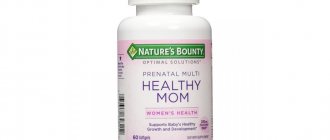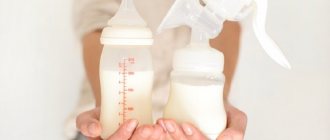Antibiotics are essential drugs for the development of bacterial infections. Antibacterial pharmacological agents are used for mastitis, sore throat, pneumonia and other diseases.
This group of medications for the treatment of nursing mothers is divided into categories of prohibited and permitted drugs. In the first case, breastfeeding is suspended or requires adherence to a strict regime. Lactation processes are supported by pumping.
When prescribing drugs from the second group, natural feeding is not interrupted, provided that the young mother follows the recommended doses. Flemoxin Salutab, which is also prescribed during breastfeeding, is considered a penicillin antibiotic. However, the product has dosing features and also involves a risk for the baby in terms of sensitization.
Description of the antibiotic
Flemoxin Solutab is a semi-synthetic antibiotic from the penicillin group, manufactured by the pharmaceutical company Astellas Pharma. This is a medicine with a bactericidal effect that is active against gram-positive and gram-negative microorganisms. The active ingredient is amoxicillin.
The components of the drug inhibit protein synthesis of the bacterial cell wall. As a result, the reproduction and growth of harmful microorganisms stops.
The medication is quickly absorbed in the body and is resistant to gastric juice. Absorbed easily regardless of food intake. The peak concentration of amoxicillin in the blood occurs after 2 hours. The drug is excreted by the kidneys (60%) and liver (15%). If the kidneys are functioning normally, the half-life is 1.5 hours. The drug does not inhibit the natural bacterial flora of the intestine. This means that the risk of developing dysbiosis is minimal. Therefore, the drug is used to treat children, during pregnancy and during breastfeeding.
Advantages of Flemoxin Solutaba

This drug has a number of positive properties:
- Quickly enters the blood.
- Characterized by hypoallergenic properties.
- Safe for the stomach.
- Does not depend on food intake.
- Has a citrus taste.
- Easily soluble in the mouth.
- No addiction.
From the point of view of doctors, Flemoxin Solutab is the most improved drug compared to Amoxicin.
pharmachologic effect
Solutab has a wide spectrum of action; the drug is active against a large number of opportunistic and pathogenic microorganisms. An antimicrobial drug has a bactericidal effect.
The antibacterial drug is active against staphylococci, streptococci, gonococci, meningococci, Escherichia coli, Shigella, Salmonella, chlamydia, Helicobacter pylori bacteria, etc. The drug is part of the penicillin group, and therefore, like all representatives of this class, cannot resist β-lactamases (enzymes that destroy penicillins).

The drug inhibits the growth and reproduction of pathogens and stops the development of infection. The components penetrate inside the cells, protecting the body from the harmful effects of pathogenic bacteria. An improvement in the patient's condition is observed 2–3 days after the start of treatment.
The drug does not overload the inner lining of the stomach, unlike antibiotics that are available in capsule form. Chew or dissolve the tablet in water before and after meals. The antimicrobial drug can be taken by children, as well as during pregnancy and breastfeeding.
Efficacy of the drug
To reduce pain from mastitis, antibiotics are used in conjunction with sulfonamides and painkillers. It is advisable to use the ointment locally for mastitis. The components of the antibiotic medicinal mass penetrate deeply into the affected tissues and act directly at the site of the disease.
Vishnevsky ointment or antibacterial heparin gel effectively eliminates pain and inflammation in glandular tissues and is actively used in complex treatment.
Only the affected areas need to be smeared. You can apply Seimova ointment or heparin. Syntomycin helps a lot. For treatment you need to use Syntomycin ointment.
Composition and dosage form
Soluble tablets consist of the following components:
- amoxicillin trihydrate;
- microscopic cellulose;
- desparged cellulose;
- vanillin;
- crospovidone;
- food additives with lemon and tangerine flavors;
- magnesium salt of stearic acid;
- saccharinate
The drug is available in the form of dispersible (soluble) tablets. Tablet weight 0.13 g, each package contains 5 or 7 pieces. There are 2 or 4 packs in a pack, there are also instructions for use.

Tablets weighing 0.25, 0.5 or 1 g are packaged in packages of 5 pieces each. There are 4 packs in a pack along with instructions.
These are oval-shaped tablets that have a white or yellowish tint. Each tablet is divided by a stripe in the middle, there are digital markings (23, 232, 234, 236) and the Astellas Pharma logo.
Tablets are used in modern medicine for infectious diseases of a bacterial nature.
Folk recipes as an auxiliary measure against lactostasis and mastitis
Traditional medicines – compresses, the effectiveness of which is recognized even by official medicine, can significantly alleviate a woman’s condition with lactostasis and avoid mastitis.
The main component of the recipes is a leaf of ordinary white cabbage. This plant has long been known for its ability to relieve various inflammations. Can be combined with different ingredients: beets and cabbage; carrots and cabbage; potatoes and cabbage.
For a compress, cabbage leaves are prepared as follows:
For an uncomplicated type of lactostasis, a compress simply made from a cabbage leaf is enough, applied to the affected breast during the day as it warms up.
When lactostasis is advanced or mastitis has developed, compound compresses are made.
The other ingredients listed above are grated on a coarse grater, and the juice is squeezed out so that it does not drip.
The compress is made like this:
- Take a plastic bag and tear it on the sides to create a long rectangle.
- Place two sheets on the bag approximately at the distance of the mammary glands, with the indentation facing up, to form two cups.
- Inside the cabbage cups, other grated ingredients, for example, carrots, are laid out in a thin layer with compaction on problem areas.
- The compress together with the package should be carefully placed on the chest with cups and pressed on top with a bra.
- The structure around the body is wrapped in soft, warm fabric on top.
Indications
The drug is concentrated in high doses in the respiratory tract, so it is often used to treat the respiratory and ENT organs. Main indications: bronchitis, pneumonia, tracheitis, laryngitis, pharyngitis, etc.

The medication is used for nephritis and genitourinary infections. And that’s all, because the antibacterial drug is observed in high concentrations in the kidneys, as it is excreted through this organ. In case of renal failure, the medication is not recommended.
About 20% of the drug is excreted through the liver, and therefore it is concentrated in this organ. Cholecystitis and cholangitis are treated with antibiotics.
An antibacterial drug is used to treat sexually transmitted infections. Respiratory and urinary tract infections can be treated empirically, based only on symptoms and not test results. Infectious lesions of the biliary and reproductive systems are treated only after laboratory tests. This is necessary to find out how sensitive the bacteria are to Flemoxin. The drug is also used to treat gonorrhea and ulcers.
Contraindications to physical methods of treatment
Physiotherapy for lactostasis is not carried out if the following contraindications are present:
- acute stage of mastitis;
- malignant neoplasms;
- mastopathy;
- fibroadenomatosis of the mammary glands.
Lactostasis is not only discomfort and pain for a young mother, but also, in advanced cases, a threat to health. This is a condition that all expectant mothers should know about, because it is easier to prevent than to treat. But even if lactostasis occurs, timely and correct actions by a woman will help quickly cope with the problem.
Benign diseases of the mammary gland occupy one of the leading positions in the problems of the female reproductive system. The treatment of these diseases, and in particular, physiotherapy for mastopathy, is of great interest among the fair sex. To get rid of pathology, it is important to understand the essence of the disease and the possible consequences of using physical influence on the chest, as well as to understand the permitted and prohibited options for conducting physical procedures.
Read in this article
Directions for use and dosage
Flemoxin Solutab is taken orally before or after meals. The tablet is dissolved or dissolved in liquid (purified water or syrup).
Treatment regimen:
- children 1–3 years old – 0.25 g twice a day or 0.13 three times a day;
- children 4–10 years old – 0.25 g three times a day or 0.38 g twice a day;
- children over 11 years old and adults - from 0.5 to 0.7 g twice a day.
Relapses, chronic diseases or severe infections are reasons to prescribe 1 g of medication three times a day, but this decision is made only by the attending physician.

If the patient has gonorrhea, the dosage is as follows - 3 g of the drug once a day. If the patient has renal failure, the dose of the drug is reduced. If you need to take larger doses of the drug, use 1000 mg tablets. Take this medicine with caution if you are pregnant or breastfeeding. The dosage is prescribed only by the attending physician!
The influence and effect of antibiotics on the body
Before choosing an antibiotic, you should consult your doctor to determine the daily dosage. These drugs can be purchased without a prescription, but treatment must be prescribed by a doctor.
Antibiotic Ospamox. Ospamox is produced in Austria. Prescribed for acute mastitis in women. After the start of administration and ingestion, the concentration of substances in the blood changes. Plasma is in altered structural and biochemical equilibrium for 1-2 hours. If a woman has not stopped breastfeeding, trace amounts of the substance may be found in the milk. Can be administered as suspensions of 5 ml twice a day.
Antibiotic Flemoxin-Solutab. The drug is manufactured in the Netherlands. Belongs to the first production line and is well used in outpatient practice. Treatment with this drug is prescribed to eliminate bacteria in mastitis. If prenatal mastitis is detected, it has no contraindications for pregnant women. It is well absorbed, does not cause allergic reactions, and has no side effects. Not prohibited during breastfeeding. Taken as tablets, can be divided into parts, chewed or washed down with juice. Soluble in liquids, can be consumed as a medicinal drink. Does not contain sugar, salt. Apricot taste.
Antibiotic Hiconcil. Antibiotic produced in Slovenia, KRKA. Prescribed only as prescribed by a doctor and only for serous mastitis. Allowed during pregnancy and lactation. Can be taken in the form of capsules, tablets, suspensions. Capsules come in 250 mg and 500 mg. The trihydrate in powder form is also consumed orally as a diluted dry composition with water. Treatment is recommended when taking 5 ml.
Contraindications
An antibiotic is not prescribed in case of hypersensitivity to the components of the drug.
Contraindications for use:
- lymphocytic leukemia;
- Epstein-Barr viral infection;
- functional kidney disorder;
- severe infections of the digestive tract with the following symptoms: vomiting, diarrhea, dehydration;
- ulcerative processes in the intestines.
Pregnant and nursing mothers can take this antibiotic only after being prescribed by their doctor.
Principles of antibiotic therapy
In order for antibiotics to be beneficial in the treatment of mastitis, several principles should be followed:
- As a preventative measure, weak-acting medications are prescribed for no more than 5 days.
- Potent medications are prescribed depending on the severity of mastitis.
- Antibiotics are selected depending on the pathogen that they can affect and which provoked mastitis.
- They drink antibiotics for mild forms of the disease, intravenously or intramuscularly for severe ones.
- The same antibiotic should not be taken for more than 1-2 weeks.
- You should read the instructions for each drug, which indicate side effects and contraindications that should be taken into account when choosing.
- Purulent mastitis is treated not only with antibiotics.
- Many antibiotics are not taken during pregnancy and lactation because they are contraindicated.
- The dosage of the medicine is not prescribed independently. This should be done by a doctor.
go to top
Flemoxin during lactation and pregnancy
As the instructions say, the antibiotic is not recommended for use during pregnancy and breastfeeding. The drug is taken in cases where the expected positive effect outweighs the risk of side effects. The doctor must constantly monitor the patient's condition.
After administration, part of the active substance passes into the mother’s milk, and therefore, when breastfeeding, it is better to give preference to safer drugs or transfer the child to artificial nutrition.
Self-medication can lead to irreparable consequences!
Strictly follow your doctor’s recommendations, because your child’s health depends on it. Subscribe to our VKontakte group
Prevention of serous mastitis
Serous mastitis may either imply a refusal to breastfeed or a continuation of this process. A woman can breastfeed or express milk, which is necessary to avoid stagnation that does not contribute to recovery. The following antibiotics are used as prophylaxis:
- Cephalosporins of the first and second generations.
- Semi-synthetic penicillins: Amoxicillin, Sulbactam, Clavulanic acid, Lactamase inhibitors.
These drugs are sufficient at the initial stage of mastitis. Gram-positive bacteria are detected, which include Salmonella, Escherichia, Proteus, Shigella. Antibiotics are taken without causing side effects. In this case, concomitant medications are not needed, since antibiotics do not provoke dysbacteriosis and stomach upset.

Amoxicillin is prescribed to people of all ages because it causes virtually no side effects, is widely available (93%) and is easily tolerated. There are practically no contraindications or allergic reactions. Medicines that contain amoxicillin are:
- Hiconcil.
- Amoxicillin-ratiopharm.
- Ospamox.
- Grunamox.
- Flemoxin.
- Ranoxil.
- Amotid.
go to top
Complications
If diagnosis and treatment are not timely, purulent mastitis is complicated by generalization of the inflammatory process. Inflammation can affect nearby muscles and subcutaneous tissue or spread throughout the body. In the most severe cases, a woman develops septic endocarditis, sepsis and infectious-toxic shock. Long-term consequences of purulent inflammation of the mammary gland are its cicatricial deformation, suppuration of the postoperative wound, and the formation of a milk fistula. Patients have an increased risk of lactostasis and mastitis after the next birth.









